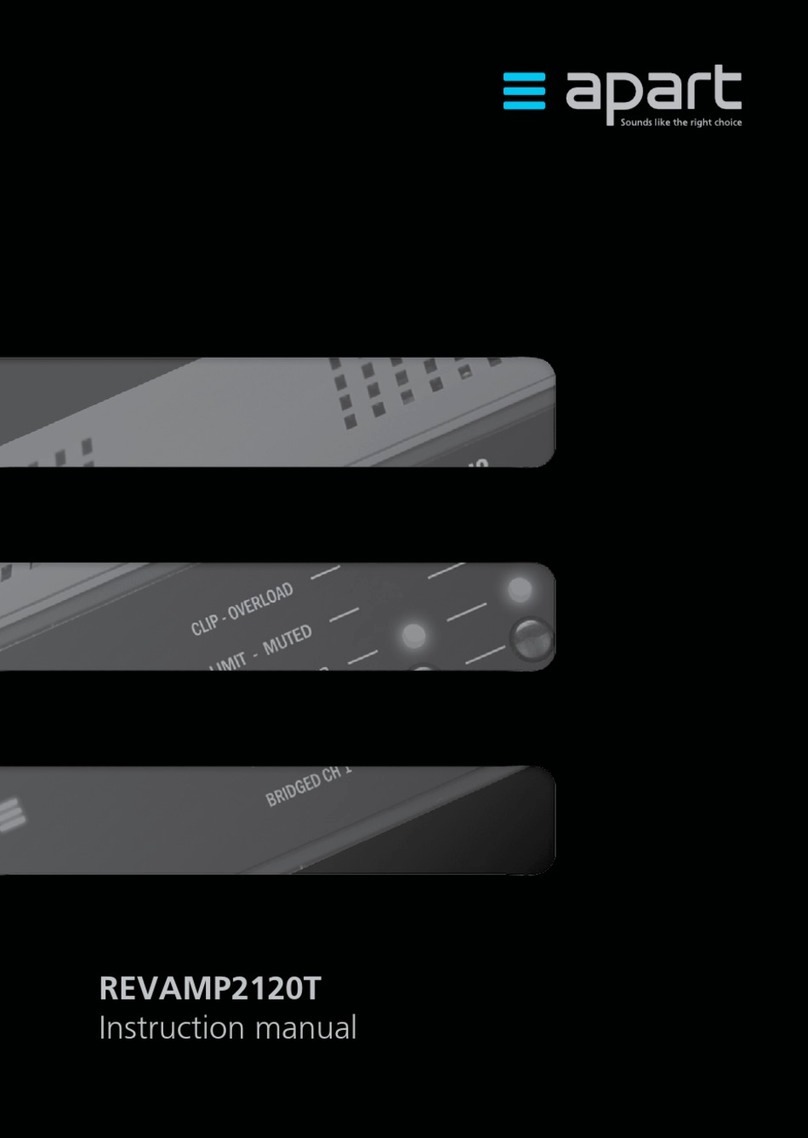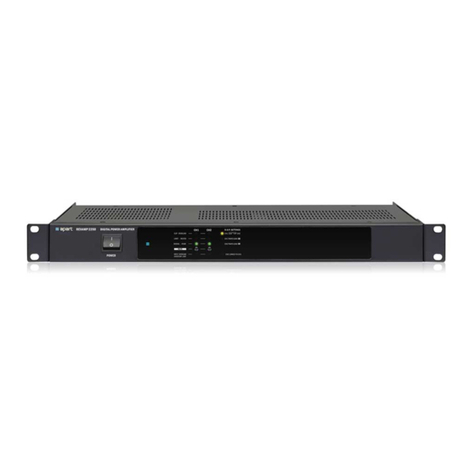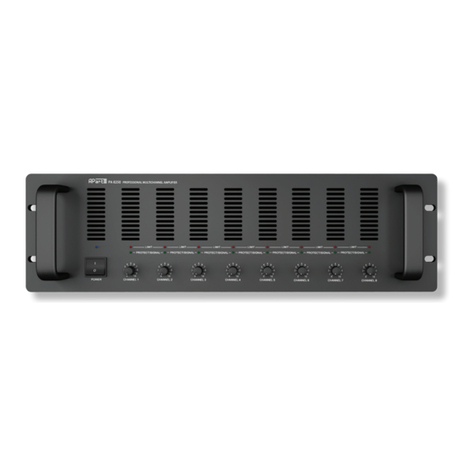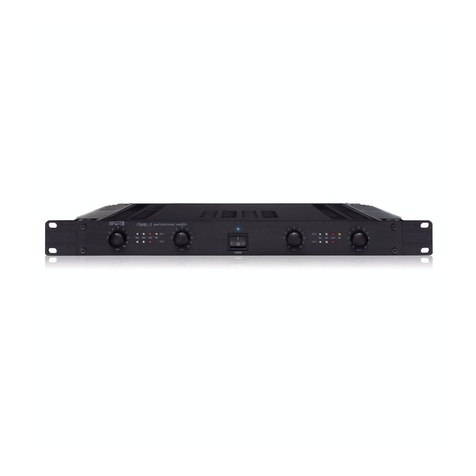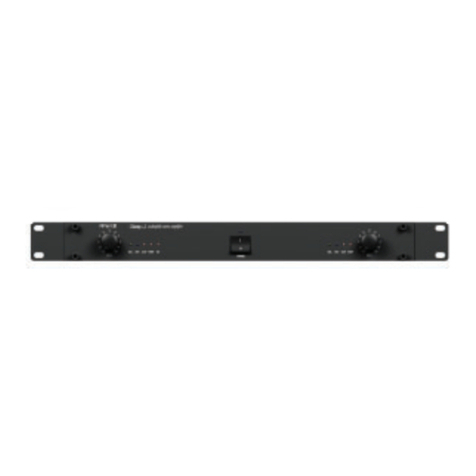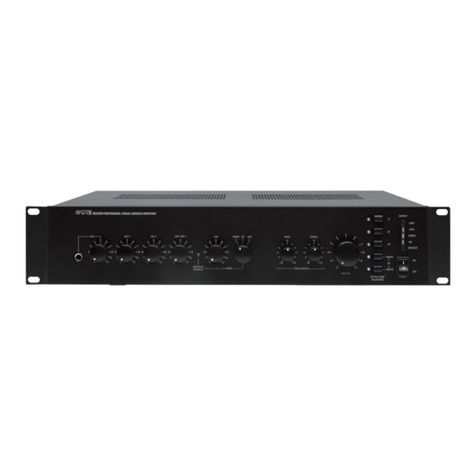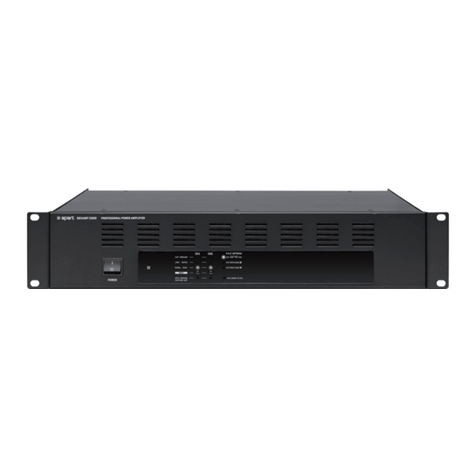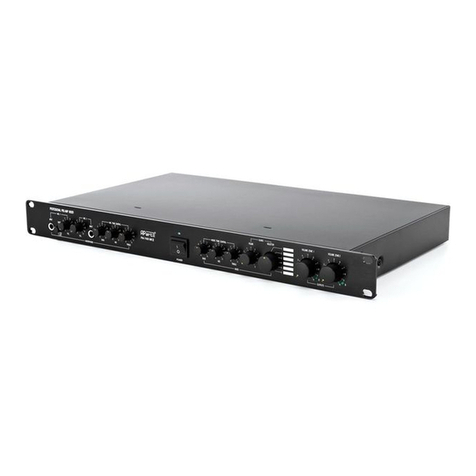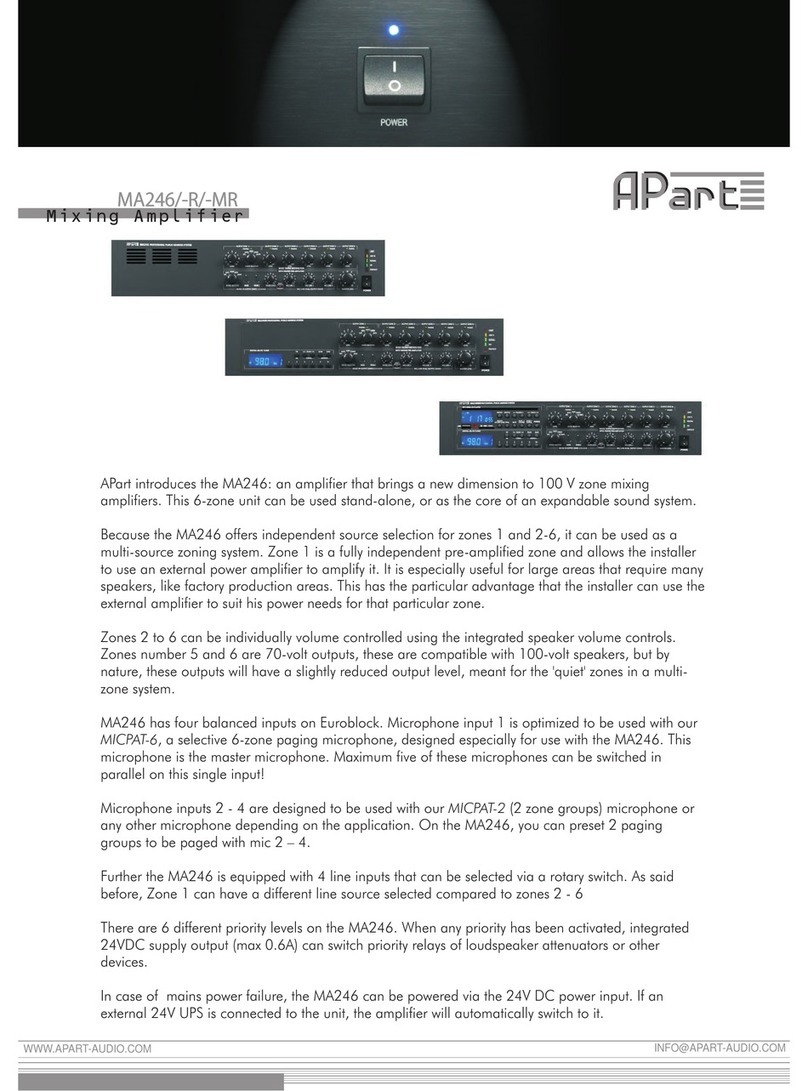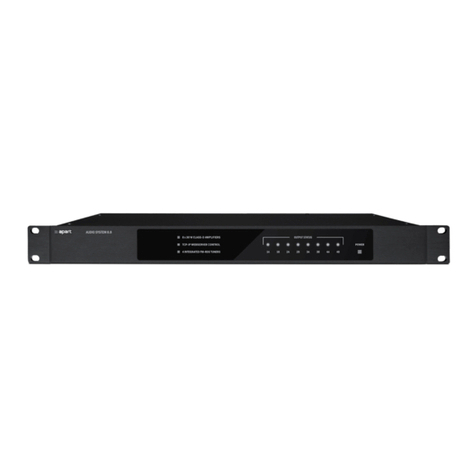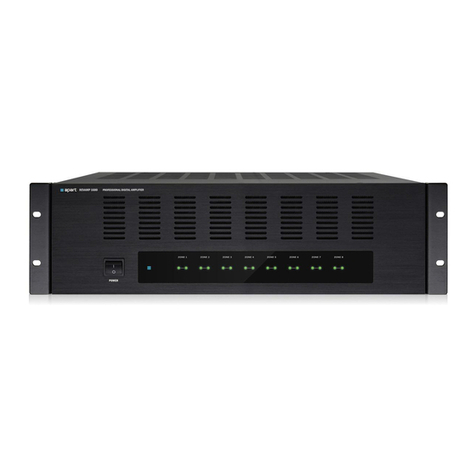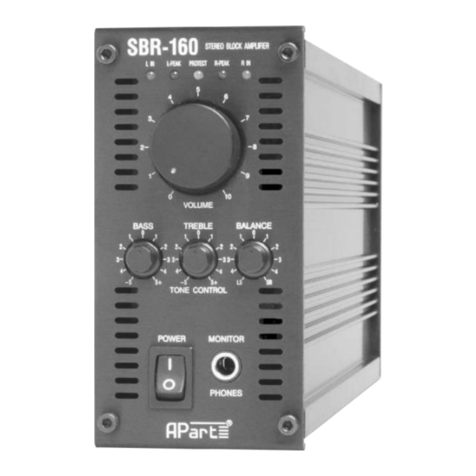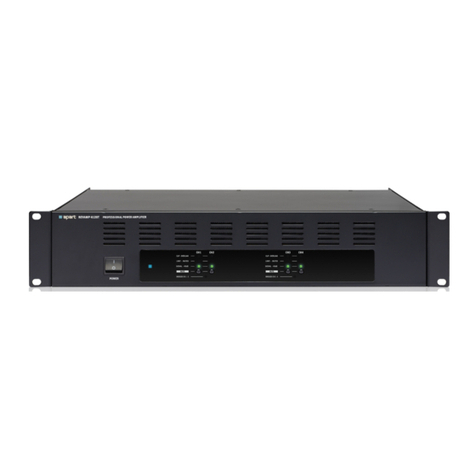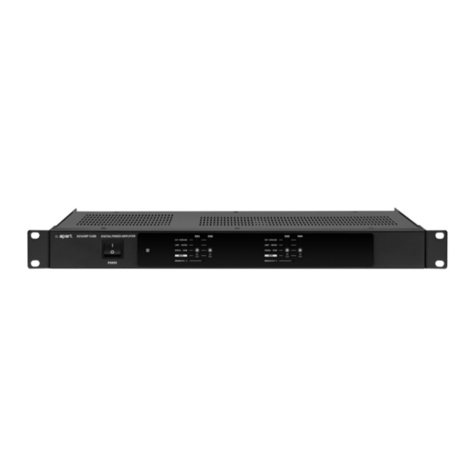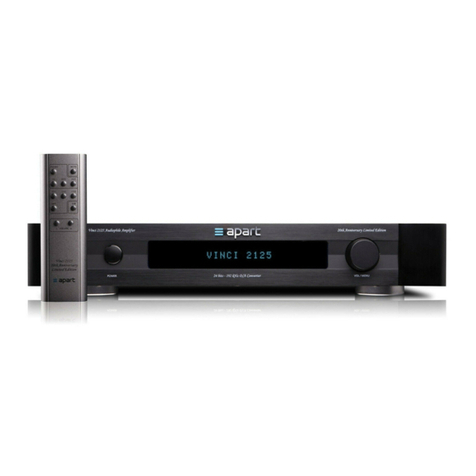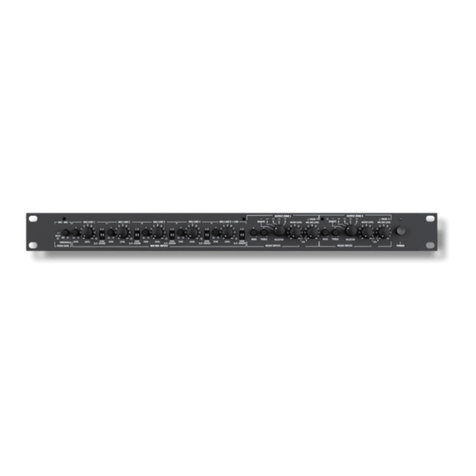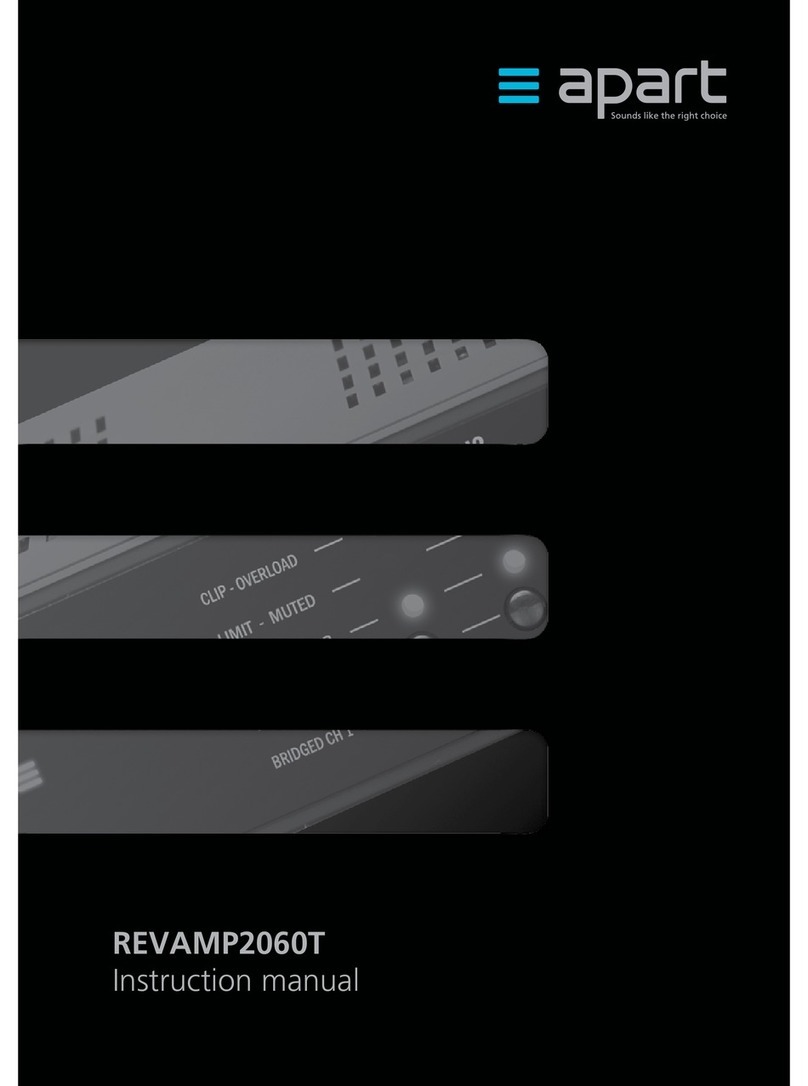MIXING AMPLIFIERSMIXING AMPLIFIERS
29
Outputs Speaker selector
Zone 1 3 on/off
Zone 4 paging on/off music on/off
Speaker zone output, euro block
High Z zone 1-2-3-4 100V
Speaker out; euro block
High Z 50 (12,5 ? ) 70 (24,5 ?) 100V (50 ? )
Low Z 8 ?
Phantom power
Mic 1-2-3-4 14V; internal jumpers
Pre amp out
Level 1V
Tuner (RCAmono) , CD (RCA Stereo)
Level 300 mV
CD OUT (RCAStereo) Music On Hold
Level 500mV
Record out; RCA mono
Level 1V
Priority out
Level 24 V DC; max 1A, short circuit protected
Chime 2 tone
activated by contact closure;
euro block DIN5
on/off and level set by trimmer
Priority I Emergency input / telephone
200 mV; 1 kHz VOX threshold
mutes all other signals
> 40 dB
II Vox mute only for mic 1
0,6 mV; 1 kHz VOX threshold
mutes mic 2,3 & 4 + music
on/off/level set by trimmer
> 40 dB
III Priority contact
> 40 dB
mutes all music inputs
Technical Specifications
1. Power switch. Here you can switch the power on and off.
2. Overload indicator. This red LED illuminates when one of the protections have been activated. No or distorted
sound will be heard anymore. This will be in case of overheating, being the result of drawing too much power from
your amplifier, or the impedance of the speaker lines connected are below the minimum load impedance (see17).
3. Level indicators/clip-limit. A green LED will light after powering on. To work within normal conditions the volume
indicator should be kept under 0dB (100%). At -2,5dB a limiter will be activated. This red LED indicates that the “auto
gain circuit” keeps the level below clipping. This is NOT a clip indicator, but an indication of
the “automatic gain control”.
4. Zone selectors. With these selectors you can activate the zone outputs. A green led at the left of the switches will
confirm that you have activated zone 1 to 3. For zone 4, two selectors are available. By means of those two selectors
you can decide to send background music only, spoken messages only, both or none of them. Two yellow leds will
confirm your selection. When you have selected the music only mode for zone 4, there will be silence during paging.
5. Master level control. Here you can adjust the desired volume of the overall signal.
6. Microphone 1 input. This balanced ¼” TRS phone jack has been wired in parallel with the other three input
options for microphone 1 at the back. For satisfying operation, use only one of these inputs at the time for microphone
1. Microphone 1 can be given a priority over all other inputs by using the VOX priority (see 29).
7. Microphone 1 level control. Adjusts the volume of the microphone connected to one of the four input connectors
(1/4” jack, XLR3 combo jack, DIN5 or euro block).
8. Microphone 2 3 level control. By turning each control clockwise the desired level of that input in the total mix is
set. To decrease these levels, turn counter-clockwise. The volumes of the inputs not in use, should be set fully
counter-clockwise. If not, hiss might occur.
9. Microphone 4 / line 4 level control. Adjusts the input signal of the microphone connected to the XLR combo jack
at the back or the line source connected to stereo RCA input 4.
10. “Muted by priority” led. This red led will blink when any priority status has been activated.
11. Music level control. Here you can adjust the level of the line source selected.
12. Line source selector. Select the desired music source to be heard (AUX, CD or TUNER).
13. Bass control. Adjust as per your taste. In reverberant rooms intelligibility can be increased by decreasing bass.
The centre position gives you a flat response.
14. Treble control. Adjust the level as per your taste or needs. Adding high frequencies gives brilliance to your
sound. High frequency feedback can be removed by decreasing treble. The centre position gives you a flat response.
Front panel
14
3
7
56
2
8 8 9
10 1112 13 14
Frequency response 40Hz 25kHz (+1/-3 dB)
Distortion <0,3% @ -6dB, 1kHz
Bass control +/- 10dB, 100 Hz
Treble control +/- 10dB, 10 kHz
S/N amplifier: better than 95dB, 22Hz 22kHz
line: better than 80dB, 22Hz 22kHz
mic: better than 65dB, 22Hz 22kHz
LED indicators limiter active, red
signal 100%, yellow
signal -25 dB, green
power on, green
protection active, red
Zone active indicators Z1, Z2 and Z3 green LED
Z4 music on/off, orange
Z4 paging allowed on/off, orange
Muted by priority LED any of the priority modes active, red
Weight approx.12,7 kg
Dimensions 430(W) x 88(H) x 356(D)mm
19” wide, 2U high
Operating temperature -10 to +45°C
Inputs Mic input 1; ¼” TRS phone jack at the front;
XLR3 combo, DIN5; Euro block
Sensitivity 1,5 mV
Impedance 600 ?
S/N (at max. volume) > 65 dB
Phantom power 14 V (internal jumper)
Frequency response > 80Hz->15Khz (+1/-3 dB)
Vox mute trigger level 0,6 mV, 1Khz, mutes mic 2,3,4+music, > 40 dB
Mic input 2,3 & 4: XLR3 balanced
Sensitivity 1,5 mV
Impedance 600 ?
S/N (at max. volume) > 65 dB
Phantom power 14 V (internal jumper)
Frequency response > 80Hz->15Khz (+1/-3 dB)
Emergency input; euro block
Sensitivity 1 V
Impedance 600 ?
S/N (at max. volume) > 80 dB
Frequency response > 100Hz-> 25Khz (+1/-3 dB)
Mute mutes all, > 40 dB
Aux input; RCA
Sensitivity 500 mV (-6 dB)
Impedance 22 k?
S/N (at max. volume) > 80 dB
Frequency response > 40Hz-> 25Khz (+1/-3 dB)
Line 4; RCA
Sensitivity 200 mV (-14 dB)
Impedance 47 k?
S/N (at max. volume) > 80 dB
Frequency response > 40Hz-> 25Khz (+1/-3 dB)
CD in
Sensitivity 500 mV (-6 dB)
Impedance 5 k?
S/N (at max. volume) > 80 dB
Frequency response > 40Hz-> 25Khz (+1/-3 dB)
Tuner
Tuning rangeFM 87,5 -108.0 MHz (50 kHz step)
AM 531 1602 kHz (9 kHz step)
Aerial terminals 75 ? , unbalanced; IEC - male
AM antenna spring lock terminal
Sensitivity at 26 dB quieting (mono) 10,3 dBf, 0,9 µV/75 ?
S/N at 40 kHz deviation; 74 dB (mono)
Harmonic distortion < 0,09% in mono mode
Frequency response 30 Hz 15kHz (+1/-3 dB, FM)
